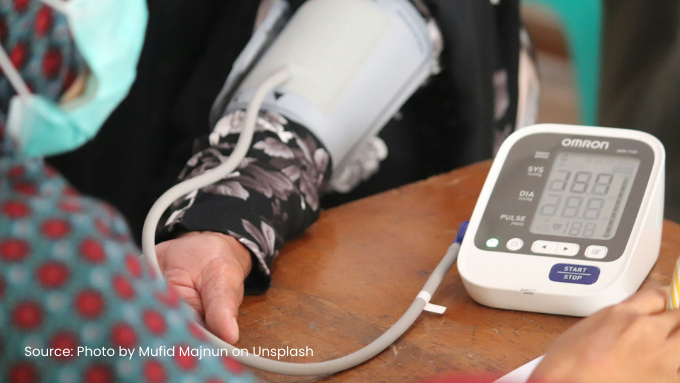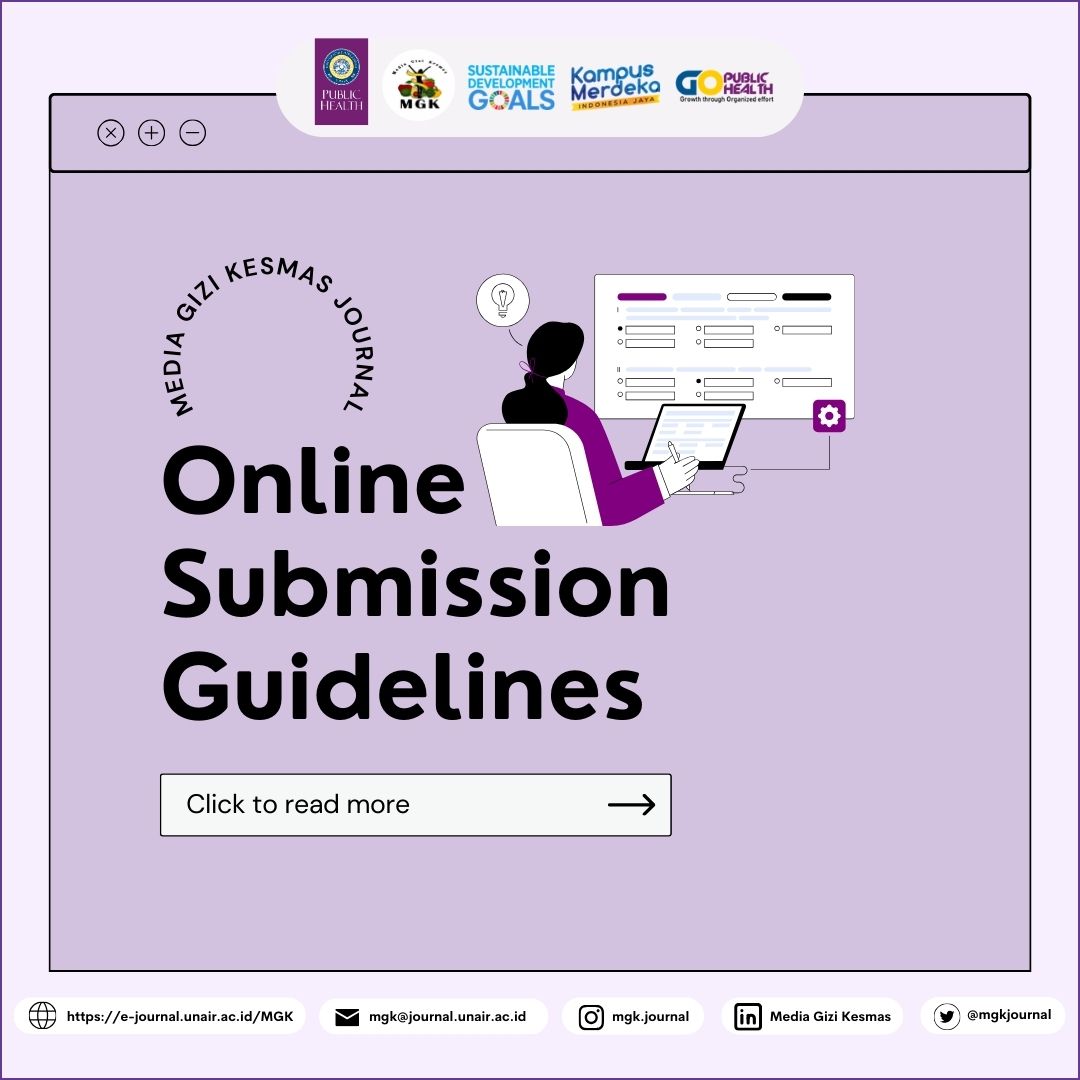The Relationship between Purine Consumption and Hypertension Against Recurrent Attacks of Gouty Arthritis in Patients at Puskesmas Kecamatan Krembangan in 2022

Downloads
Background: Gout arthritis is a systemic disease resulting from the deposition of monosodium urate (MSU) crystals. The prevalence of gouty arthritis in Indonesia is increasing. The general prevalence of gouty arthritis is 1-4% of the general population. In 2013 in East Java, the incidence of gouty arthritis reached 26.4%. Meanwhile in Surabaya, in 2011 the prevalence of gout arthritis touched 56.8%. Untreated gouty arthritis can result in repeated attacks on the sufferer. This can cause disruption of quality of life, disability, and even loss of work productivity.
Objectives: The purpose of this study was to analyze the relationship between purine consumption and history of hypertension with repeated attacks of gouty arthritis in patients at the Puskesmas Kecamatan Krembangan.
Methods: This research was an observational study used a case-control study design, namely comparing cases from the case group and the controlled group with a ratio of 1:2. The population in this research was all sufferers of gouty arthritis who lived in the working area of the Krembangan District Public Health Center, Surabaya City, totaling 53 people. Sampling was done by purposive sampling technique. Test data analysis used the spearman test to determine the relationship between the two variables.
Results: The results of this study was shown by the p-valued in the variable purine consumption pattern which included a value of 0.026 with a r-value = 0.387 which meant there was a relationship between purine consumption patterns with repeated attacked with weak relationship strength. The p-value in the hypertension variable is 0.741 and the r-value = 0.06 which meant that there is almost no relationship between a history of hypertension and repeated attacked of gouty arthritis.
Conclusions: The consumption pattern of purines has a relationship with recurrent attacks of gouty arthritis with a weak relationship strength, while a history of hypertension has no relationship with the occurrence of recurrent attacks of gouty arthritis.
Afifah, I., & Sopiany, H.M. (2017) Hubungan Pengetahuan Dan Sikap Klien Dengan Tindakan Pencegahan Kekambuhan Penyakit Gout Artritis Di Puskesmas Kolongan Kecamatan Kalawat, Universitas Katolik De La Salle. Universitas Katolik De La Salle. Available at: http://repo.unikadelasalle.ac.id/id/eprint/351.
Afnuhazi, R. (2019) ‘Faktor - Faktor Yang Berhubungan Dengan Kejadian Asam Urat Pada Lansia (45 – 70 Tahun)', Human Care Journal, 4(1), p. 34. Available at: https://doi.org/10.32883/hcj.v4i1.242.
Annita and Handayani, S.W. (2017) ‘Relationship of Purin Diet With Uric Acid Levels in Gout', Jurnal Kesehatan Medika Saintika e-ISSN : 2540-961 p-ISSN : 2087-8508, 9(2), pp. 68–76. Available at: https://doi.org/http://dx.doi.org/10.30633/jkms.v9i2.171.
Ansyarullah, A., Cahyady, E. and Zurriyani, Z. (2020) ‘Hubungan Pola Konsumsi Makanan Tinggi Purin Terhadap Kekambuhan Gout Artritis Di Poli Klinik Penyakit Dalam Rs Pertamedika Ummi Rosnati Banda Aceh', Jurnal Ilmu Kedokteran dan Kesehatan, 7(4), pp. 584–592. Available at: https://doi.org/10.33024/jikk.v7i4.3285.
Danve, A. and Neogi, T. (2018) ‘Rising Global Burden of Gout: Time to Act', Physiology & behavior, 176(5), pp. 139–148. Available at: https://doi.org/10.4049/jimmunol.1801473.The.
David, H. et al. (2006) ‘Recent diuretic use and the risk of recurrent gout attacks: The online case-crossover gout study', Journal of Rheumatology, 33(7), pp. 1341–1345. Available at: www.jrheum.org%0A.
Gromova, M.., Tsurko, V. and Melekhina, A.. (2019) ‘'Rational approach to nutrition for patients with gout', The Clinician', 13(3–4), pp. 15–21. Available at: https://doi.org/10.17650/1818-8338-2019-13-3-4-15-21.
Junaidi, I. and Mayasari, L. (2020) MENCEGAH & MENGATASI BERBAGAI PENYAKIT SENDI: Asam Urat, Rematik, dan Penyakit Sendi Lainnya. Edisi 1, C. Yogyakarta: Penerbit Andi Offset.
Lin, X. et al. (2019) ‘Gender- and age-specific differences in the association of hyperuricemia and hypertension: A cross-sectional study', International Journal of Endocrinology, 2019. Available at: https://doi.org/10.1155/2019/7545137.
Manullang, I. (2016) Faktor-faktor yang Berhubungan Dengan Kejadian Asam Urat (Gout) Pada Usia ≥45 Tahun di Desa Ujung Serdang Kecamatan Tanjung Morawa Tahun 2016. Universitas Sumatera Utara. Available at: http://repositori.usu.ac.id/handle/123456789/3032.
Mumpuni, Y. and Wulandari, A. (2016) Cara jitu mengatasi asam urat : mengenali gejala, kondisi, faktor pemicu, mitos-mitos asam urat, pencegahan & penanganannya. Edited by Maya. Yogyakarta: Yogyakarta : Rapha Publishing, 2016.
Muthia, D. (2021) Pengaruh Konseling Apoteker terhadap Tingkat Pengetahuan Pasien dalam Penggunaan Allopurinol dan Analgesik di Apotek Wilayah Kota Malang. Universitas Brawijaya. Available at: http://repository.ub.ac.id/id/eprint/175411.
Ragab, G., Elshahaly, M. and Bardin, T. (2017) ‘Gout : An old disease in new perspective – A review', Journal of Advanced Research, 8(5), pp. 495–511. Available at: https://doi.org/10.1016/j.jare.2017.04.008.
Rothenbacher, D. et al. (2011) ‘Frequency and risk factors of gout flares in a large population-based cohort of incident gout', Rheumatology, 50(5), pp. 973–981. Available at: https://doi.org/10.1093/rheumatology/keq363.
Silvia, E., Suryawan, B. and Marcilia, R. (2016) ‘1. Staf Pengajar, Fakultas Kedokteran, Universitas Malahayati, Lampung 2. Mahasiswa Kedokteran, Fakultas Kedokteran, Universitas Malahayati, Lampung', Jurnal Ilmu Kedokteran dan Kesehatan, 3(4). Available at: https://doi.org/https://doi.org/10.33024/.v3i4.761.
Singh, J.A. and Gaffo, A. (2020) ‘Gout epidemiology and comorbidities', Seminars in Arthritis and Rheumatism, 50(3), pp. S11–S16. Available at: https://doi.org/10.1016/j.semarthrit.2020.04.008.
Soeroso, J. and Algristian, H. (2011) Asam urat. Depok: Penebar Plus.
Widyanto, F.W. (2017) ‘Artritis Gout Dan Perkembangannya', Saintika Medika, 10(2), p. 145. Available at: https://doi.org/10.22219/sm.v10i2.4182.
Yuniarti, S. et al. (2017) ‘Dietary Pattern and Arthritis Gout Recurrence In Puskesmas Krembangan Selatan Surabaya', Proceeding Of Surabaya International Health Conference, 1(1), pp. 95–98.
Zahroh, C. and Faiza, K. (2018) ‘Pengaruh Kompres Hangat terhadap Penurunan Nyeri pada Penderita Penyakit Artritis Gout', Jurnal Ners dan Kebidanan (Journal of Ners and Midwifery), 5(3), pp. 182–187. Available at: https://doi.org/10.26699/jnk.v5i3.art.p182-187.
Copyright (c) 2024 Eucharistia Crisantika, Nely Sintia; Chatarina Umbul Wahyuni

This work is licensed under a Creative Commons Attribution-ShareAlike 4.0 International License.
Media Gizi Kesmas by Unair is licensed under a Creative Commons Attribution-ShareAlike 4.0 International License.
1. The journal allows the author(s) to hold the copyright and to retain the publishing right of the article without restrictions.
2. The legal formal aspect of journal publication accessibility refers to Creative Commons Attribution-Share-Alike (CC BY-SA).
3. The Creative Commons Attribution-Share-Alike (CC BY-SA) license allows re-distribution and re-use of a licensed work on the conditions that the creator is appropriately credited and that any derivative work is made available under "the same, similar or a compatible license”. Other than the conditions mentioned above, the editorial board is not responsible for copyright violations.


















